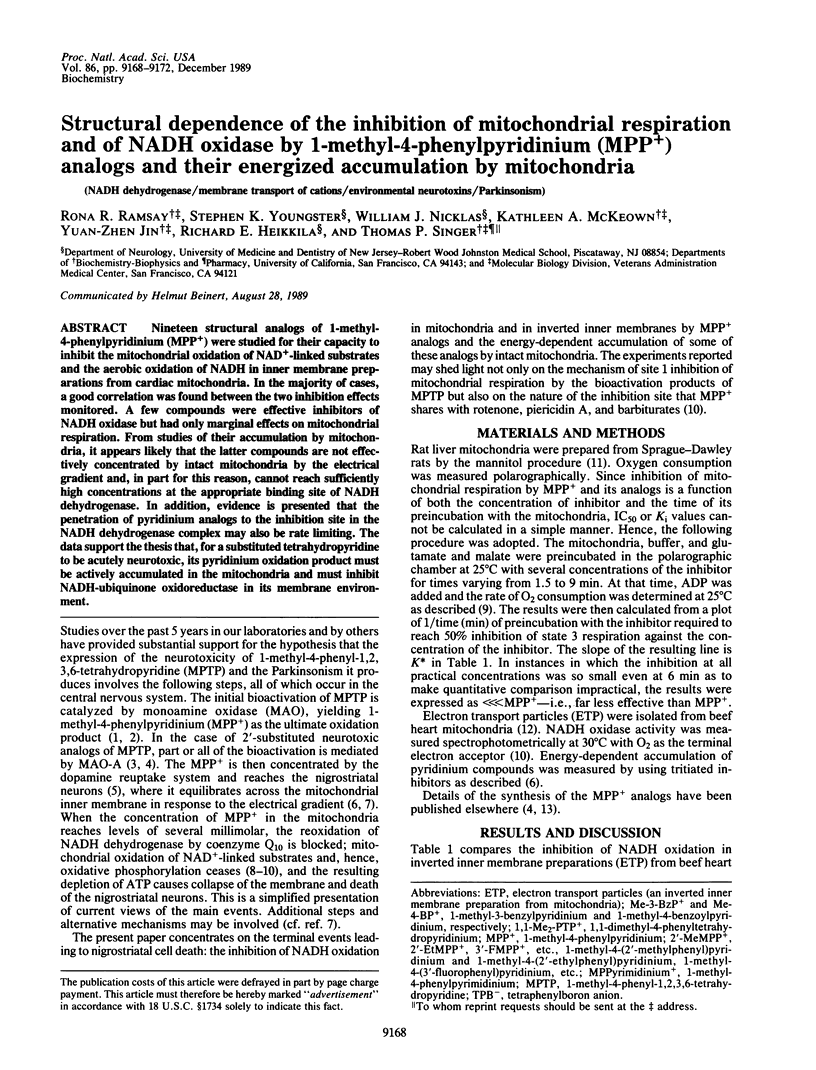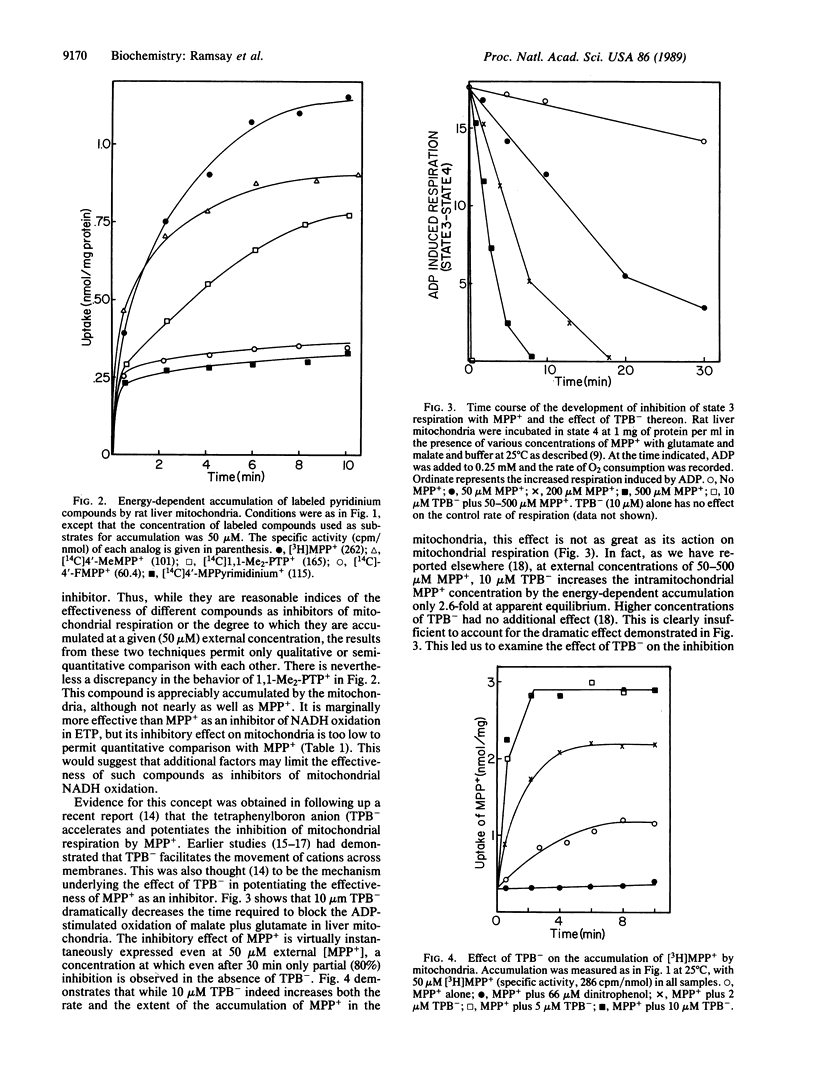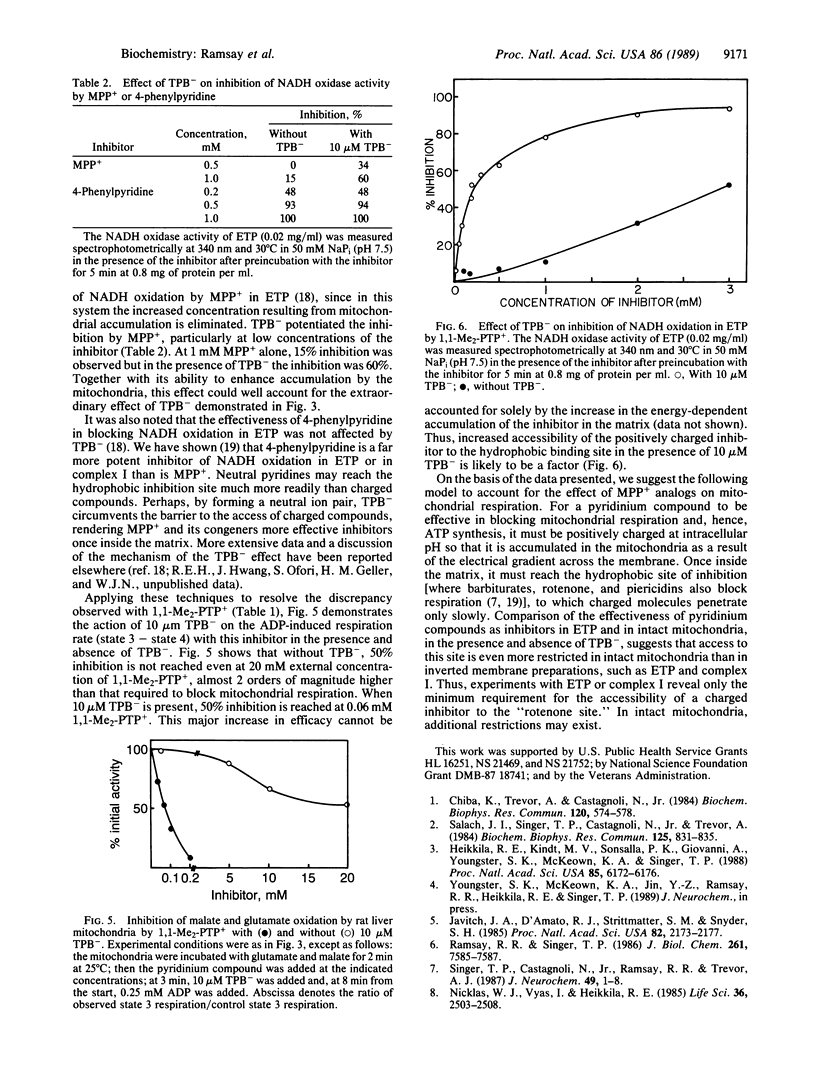Abstract
Nineteen structural analogs of 1-methyl-4-phenylpyridinium (MPP+) were studied for their capacity to inhibit the mitochondrial oxidation of NAD+-linked substrates and the aerobic oxidation of NADH in inner membrane preparations from cardiac mitochondria. In the majority of cases, a good correlation was found between the two inhibition effects monitored. A few compounds were effective inhibitors of NADH oxidase but had only marginal effects on mitochondrial respiration. From studies of their accumulation by mitochondria, it appears likely that the latter compounds are not effectively concentrated by intact mitochondria by the electrical gradient and, in part for this reason, cannot reach sufficiently high concentrations at the appropriate binding site of NADH dehydrogenase. In addition, evidence is presented that the penetration of pyridinium analogs to the inhibition site in the NADH dehydrogenase complex may also be rate limiting. The data support the thesis that, for a substituted tetrahydropyridine to be acutely neurotoxic, its pyridinium oxidation product must be actively accumulated in the mitochondria and must inhibit NADH-ubiquinone oxidoreductase in its membrane environment.
Full text
PDF




Selected References
These references are in PubMed. This may not be the complete list of references from this article.
- CRANE F. L., GLENN J. L., GREEN D. E. Studies on the electron transfer system. IV. The electron transfer particle. Biochim Biophys Acta. 1956 Dec;22(3):475–487. doi: 10.1016/0006-3002(56)90058-0. [DOI] [PubMed] [Google Scholar]
- Chiba K., Trevor A., Castagnoli N., Jr Metabolism of the neurotoxic tertiary amine, MPTP, by brain monoamine oxidase. Biochem Biophys Res Commun. 1984 Apr 30;120(2):574–578. doi: 10.1016/0006-291x(84)91293-2. [DOI] [PubMed] [Google Scholar]
- Grinius L. L., Jasaitis A. A., Kadziauskas Y. P., Liberman E. A., Skulachev V. P., Topali V. P., Tsofina L. M., Vladimirova M. A. Conversion of biomembrane-produced energy into electric form. I. Submitochondrial particles. Biochim Biophys Acta. 1970 Aug 4;216(1):1–12. doi: 10.1016/0005-2728(70)90153-2. [DOI] [PubMed] [Google Scholar]
- Heikkila R. E., Kindt M. V., Sonsalla P. K., Giovanni A., Youngster S. K., McKeown K. A., Singer T. P. Importance of monoamine oxidase A in the bioactivation of neurotoxic analogs of 1-methyl-4-phenyl-1,2,3,6-tetrahydropyridine. Proc Natl Acad Sci U S A. 1988 Aug;85(16):6172–6176. doi: 10.1073/pnas.85.16.6172. [DOI] [PMC free article] [PubMed] [Google Scholar]
- Horgan D. J., Singer T. P., Casida J. E. Studies on the respiratory chain-linked reduced nicotinamide adenine dinucleotide dehydrogenase. 13. Binding sites of rotenone, piericidin A, and amytal in the respiratory chain. J Biol Chem. 1968 Feb 25;243(4):834–843. [PubMed] [Google Scholar]
- Hunziker A., Orme F. W., Macey R. I. Transport of hydrophobic ions in erythrocyte membrane: I. Zero membrane potential properties. J Membr Biol. 1985;84(2):147–156. doi: 10.1007/BF01872212. [DOI] [PubMed] [Google Scholar]
- Javitch J. A., D'Amato R. J., Strittmatter S. M., Snyder S. H. Parkinsonism-inducing neurotoxin, N-methyl-4-phenyl-1,2,3,6 -tetrahydropyridine: uptake of the metabolite N-methyl-4-phenylpyridine by dopamine neurons explains selective toxicity. Proc Natl Acad Sci U S A. 1985 Apr;82(7):2173–2177. doi: 10.1073/pnas.82.7.2173. [DOI] [PMC free article] [PubMed] [Google Scholar]
- Nicklas W. J., Vyas I., Heikkila R. E. Inhibition of NADH-linked oxidation in brain mitochondria by 1-methyl-4-phenyl-pyridine, a metabolite of the neurotoxin, 1-methyl-4-phenyl-1,2,5,6-tetrahydropyridine. Life Sci. 1985 Jul 1;36(26):2503–2508. doi: 10.1016/0024-3205(85)90146-8. [DOI] [PubMed] [Google Scholar]
- Ramsay R. R., Kowal A. T., Johnson M. K., Salach J. I., Singer T. P. The inhibition site of MPP+, the neurotoxic bioactivation product of 1-methyl-4-phenyl-1,2,3,6-tetrahydropyridine is near the Q-binding site of NADH dehydrogenase. Arch Biochem Biophys. 1987 Dec;259(2):645–649. doi: 10.1016/0003-9861(87)90531-5. [DOI] [PubMed] [Google Scholar]
- Ramsay R. R., Mehlhorn R. J., Singer T. P. Enhancement by tetraphenylboron of the interaction of the 1-methyl-4-phenylpyridinium ion (MPP+) with mitochondria. Biochem Biophys Res Commun. 1989 Mar 31;159(3):983–990. doi: 10.1016/0006-291x(89)92205-5. [DOI] [PubMed] [Google Scholar]
- Ramsay R. R., Salach J. I., Dadgar J., Singer T. P. Inhibition of mitochondrial NADH dehydrogenase by pyridine derivatives and its possible relation to experimental and idiopathic parkinsonism. Biochem Biophys Res Commun. 1986 Feb 26;135(1):269–275. doi: 10.1016/0006-291x(86)90972-1. [DOI] [PubMed] [Google Scholar]
- Ramsay R. R., Singer T. P. Energy-dependent uptake of N-methyl-4-phenylpyridinium, the neurotoxic metabolite of 1-methyl-4-phenyl-1,2,3,6-tetrahydropyridine, by mitochondria. J Biol Chem. 1986 Jun 15;261(17):7585–7587. [PubMed] [Google Scholar]
- Salach J. I., Singer T. P., Castagnoli N., Jr, Trevor A. Oxidation of the neurotoxic amine 1-methyl-4-phenyl-1,2,3,6-tetrahydropyridine (MPTP) by monoamine oxidases A and B and suicide inactivation of the enzymes by MPTP. Biochem Biophys Res Commun. 1984 Dec 14;125(2):831–835. doi: 10.1016/0006-291x(84)90614-4. [DOI] [PubMed] [Google Scholar]
- Schnaitman C., Greenawalt J. W. Enzymatic properties of the inner and outer membranes of rat liver mitochondria. J Cell Biol. 1968 Jul;38(1):158–175. doi: 10.1083/jcb.38.1.158. [DOI] [PMC free article] [PubMed] [Google Scholar]
- Singer T. P., Castagnoli N., Jr, Ramsay R. R., Trevor A. J. Biochemical events in the development of parkinsonism induced by 1-methyl-4-phenyl-1,2,3,6-tetrahydropyridine. J Neurochem. 1987 Jul;49(1):1–8. doi: 10.1111/j.1471-4159.1987.tb03384.x. [DOI] [PubMed] [Google Scholar]


